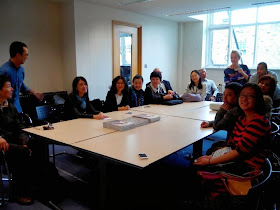You have Julius Caesar to thank for those New Year’s Day hangovers, after a night of ringing in the New Year! In 45 BC he revamped the Roman calendar and pronounced January as the first month of the year.
 |
| Coin of Janus from the reign of Antoninus Pius AD 138-161 |
January was named after the Roman god Janus, the god of beginnings, doors and gates – a very appropriate choice with the start of the New Year being a time for new starts and opening the proverbial doors to a new future and a new you (or at least the intention for a new you! Personally, my resolution to eat and drink less is turning into an annual habit!)
 |
Janus was often depicted with two faces. I’m sure it wasn’t a slur on his character but, to represent looking both to the past and the future.
|
On the 28th December, the Roman Baths hosted a "make an oscilla of a two faced Janus" event! The day was a success, with many families trying their hand at a bit of crafts!
New Year’s Day was called Kalendae Januariae and, just like today, was a day of celebration that they dedicated to Janus. On this day you could only say good things (not something I could promise!)
Cakes and sweets were eaten and presents were exchanged between family and friends. A popular gift was an oil lamp as the light of the lamp shining in the darkness symbolized looking into the unknown future that the New Year brings.
Some dates!
A sweet treat, that would have been devoured, was Hot Dates, hence the title! This comes from the recipe book of the Roman cook Apicius who lived during the 1st century AD!
To truly celebrate New Year's Day Roman style, on 1st January, we served Hot Dates to visitors and it was safe to say they went down well!
To have a go at making the dish yourself, here's the recipe! If you do make any at home you could put your creation up on The Roman Baths Facebook page! I'd love to see them!
Dates Alexandrine
Ingredients:
20 (whole) dates
20 blanched almonds
1 tsp cinnamon
Butter
Salt
Liquid honey
20 blanched almonds
1 tsp cinnamon
Butter
Salt
Liquid honey
Remove stones from dates. Roll almonds in cinnamon and stuff one in each date. Place dates on greased pan. Lightly sprinkle salt over the dates. Then coat each one with honey. Glaze in an oven then serve and enjoy!
Emma



.jpg)

